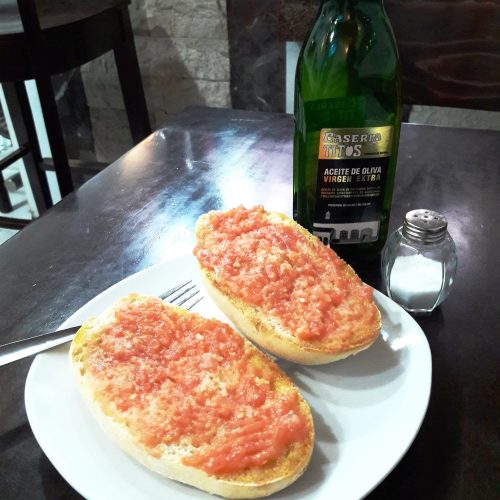
A Quick Guide to Spanish Breakfast
Dear Wes
As a lover of all-things breakfast, early morning food in Spain might not do the trick for you. If you are someone who cannot survive without a hearty breakfast, you might find that most Spanish breakfast foods won’t provide you with enough (calories, fat, protein…) to get through to lunch―at 3 pm. However, here breakfasts are meant to be a form of quick fuel for people that are not accustomed to heavy meals early in the morning and could be as simple as a glass of milk. Luckily, in Spain, you have several more options than countries such as France or Italy (which tend to only have access to sweet food such as croissants or cookies). Your basic breakfast options include:
 To drink:
To drink:
Café con leche or other coffee drinks: Coffee is a staple drink in Spain just like many other countries, but they drink it differently than in the US, or even compared to other European countries. Check out this article for more details about your coffee options.
Cola Cao: Similar to Nesquik, Cola Cao is a chocolate powder mixed into either warm or cold milk and is a popular sweet drink marketed towards younger people who might not be having a morning coffee to wake them up. At the same time, we’ve found that it is also highly enjoyed by adults who prefer not to start their day caffeinated or have a sweet afternoon treat.
Tés or influsiones: In Spanish, teas refer to those beverages which have caffeine and infusions is what they call all other, non-caffeinated beverages that are made by infusing the water with leaves, flowers, etc. You can easily get black, green, or red tea and usually chamomile or mint infusions. All other options are hit-or-miss depending on your local cafetería, or place where you will head for breakfast in the morning.
Freshly made zumo de naranja: Fresh squeezed orange juice can be found in almost every cafetería you stop in Spain, which we find to be amazing as it is a great way to start your morning. In addition, you will probably find it to be quite inexpensive when compared to other neighboring countries. Other types of juices are becoming more popular too, but this classic juice is always available.
To eat:
Tostadas: The main breakfast food for daily consumption, the tostada is a piece of toast with different toppings. You can usually get a whole or a half toast (which may be half a baguette, roll, or other type of bread). You can always find tostadas made of white (normal) bread but whole-wheat (integral) bread is also becoming more popular as well as specialty breads or allergy-free options such as gluten free. Toppings can be sweet or savory and will vary depending on both the specific cafetería as well the city you are in.
-
Sweet tostadas: Can be topped with things like butter, jam, butter and jam, nutella, or peanut butter and jelly (although, this last option is usually only available in places that cater to foreigners as Spaniards don’t tend to eat peanut butter).
-
Savory tostadas: The most popular tostada is probably tomate, or pureed tomato with olive oil and salt, but you can also get it with just olive oil, tomato with cheese, tomato with ham, or tomato with ham and cheese. You can also ask for your ham and cheese toast without tomato, but that is not as Spanish. Other savory, non-tomato options may include paté, cream cheese, avocado, or tuna although, again, the variety will depend on where you are.
Note: Learn more about the most popular tostada, de tomate, and how to make your own in this post
 Churros: Another common Spanish breakfast and usually ordered with cups of thick chocolate served warm (hot chocolate is not the right interpretation―this chocolate is like a delicious warm version of pudding or mousse), churros are a version of fried doughnuts. They are piped into boiling oil in strands and come out mostly hollow. Usually made with a very simple batter, churros tend to be vegan, even if the accompaniments are not. In addition, they should be eaten as soon as they come to the table; hot they are delicious but as they cool they lose some of their appeal. If you don’t like hot chocolate, you can always enjoy your churros with a cup of coffee and dipped in sugar.
Churros: Another common Spanish breakfast and usually ordered with cups of thick chocolate served warm (hot chocolate is not the right interpretation―this chocolate is like a delicious warm version of pudding or mousse), churros are a version of fried doughnuts. They are piped into boiling oil in strands and come out mostly hollow. Usually made with a very simple batter, churros tend to be vegan, even if the accompaniments are not. In addition, they should be eaten as soon as they come to the table; hot they are delicious but as they cool they lose some of their appeal. If you don’t like hot chocolate, you can always enjoy your churros with a cup of coffee and dipped in sugar.
Croissants: Most places will have some sort of sweet pastry on offer which, more often than not, will be a croissant. You can usually ask for butter and jam with yours, but most people just eat them plain with a cup of coffee on the side.
Warning: SPANISH CROISSANTS (AND SPANISH PASTRY IN GENERAL) ARE NOT LIKE FRENCH PASTRY WHICH HAVE A BUTTER BASE, BUT ARE MADE MOSTLY WITH PIG LARD OR, SOMETIMES, OLIVE OIL. JUST KEEP THIS IN MIND IF YOU ARE A VEGETARIAN.
 Crepes: A rather new option available in some places, sweet and savory crepes can be a fun way to start your morning. Be forewarned, however, although they are French-inspired, you probably won’t find somewhere that makes their crepes the same as in France. Does this make them less delicious? Absolutely not! We just want to help you align your expectations to avoid any disappointment.
Crepes: A rather new option available in some places, sweet and savory crepes can be a fun way to start your morning. Be forewarned, however, although they are French-inspired, you probably won’t find somewhere that makes their crepes the same as in France. Does this make them less delicious? Absolutely not! We just want to help you align your expectations to avoid any disappointment.
Eggs and…: This option, if available, was put on the menu for a guiri like you. Very few Spanish people we know will eat something like eggs regularly for breakfast. Anything with eggs, sausages, or the like will be a Spanish impression of British or American breakfast dishes. They will probably be decent, but don’t expect a copy of what you get back home because these are not traditional foods.
What is your favorite Spanish breakfast food?
Sincerely,
Spain





2 Comments
ishikasingh5575@gmail.com
Today if someone asks me what you saw best then I would like to say that I saw your post best today and it is a very beautifully written post which I appreciate. And I also think that if you see someone’s post and it is beautiful and well written, that should be appreciated.
Sincerely, Spain
We are glad you enjoyed the post and will try to pass on the positive energy!